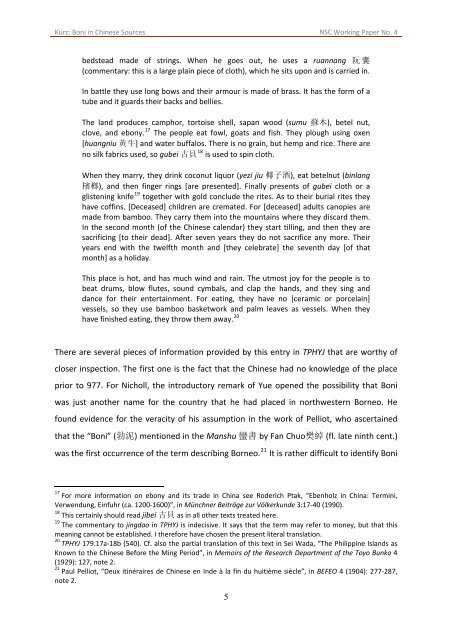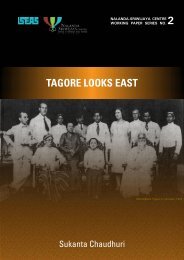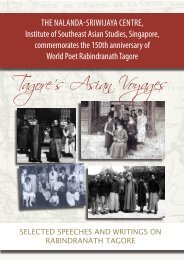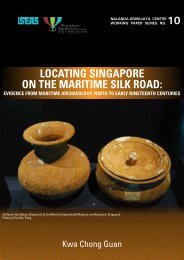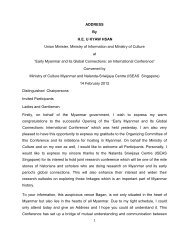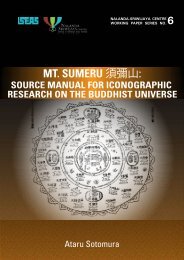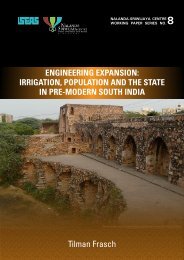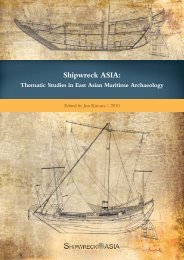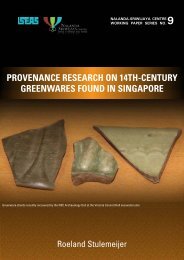Boni in Chinese Sources - Nalanda-Sriwijaya Centre - iseas
Boni in Chinese Sources - Nalanda-Sriwijaya Centre - iseas
Boni in Chinese Sources - Nalanda-Sriwijaya Centre - iseas
Create successful ePaper yourself
Turn your PDF publications into a flip-book with our unique Google optimized e-Paper software.
Kurz: <strong>Boni</strong> <strong>in</strong> Ch<strong>in</strong>ese <strong>Sources</strong> NSC Work<strong>in</strong>g Paper No. 4bedstead made of str<strong>in</strong>gs. When he goes out, he uses a ruannang 阮 囊(commentary: this is a large pla<strong>in</strong> piece of cloth), which he sits upon and is carried <strong>in</strong>.In battle they use long bows and their armour is made of brass. It has the form of atube and it guards their backs and bellies.The land produces camphor, tortoise shell, sapan wood (sumu 蘇 木 ), betel nut,clove, and ebony. 17 The people eat fowl, goats and fish. They plough us<strong>in</strong>g oxen[huangniu 黃 牛 ] and water buffalos. There is no gra<strong>in</strong>, but hemp and rice. There areno silk fabrics used, so gubei 古 貝 18 is used to sp<strong>in</strong> cloth.When they marry, they dr<strong>in</strong>k coconut liquor (yezi jiu 椰 子 酒 ), eat betelnut (b<strong>in</strong>lang檳 榔 ), and then f<strong>in</strong>ger r<strong>in</strong>gs [are presented]. F<strong>in</strong>ally presents of gubei cloth or aglisten<strong>in</strong>g knife 19 together with gold conclude the rites. As to their burial rites theyhave coff<strong>in</strong>s. [Deceased] children are cremated. For [deceased] adults canopies aremade from bamboo. They carry them <strong>in</strong>to the mounta<strong>in</strong>s where they discard them.In the second month (of the Ch<strong>in</strong>ese calendar) they start till<strong>in</strong>g, and then they aresacrific<strong>in</strong>g [to their dead]. After seven years they do not sacrifice any more. Theiryears end with the twelfth month and [they celebrate] the seventh day [of thatmonth] as a holiday.This place is hot, and has much w<strong>in</strong>d and ra<strong>in</strong>. The utmost joy for the people is tobeat drums, blow flutes, sound cymbals, and clap the hands, and they s<strong>in</strong>g anddance for their enterta<strong>in</strong>ment. For eat<strong>in</strong>g, they have no [ceramic or porcela<strong>in</strong>]vessels, so they use bamboo basketwork and palm leaves as vessels. When theyhave f<strong>in</strong>ished eat<strong>in</strong>g, they throw them away. 20There are several pieces of <strong>in</strong>formation provided by this entry <strong>in</strong> TPHYJ that are worthy ofcloser <strong>in</strong>spection. The first one is the fact that the Ch<strong>in</strong>ese had no knowledge of the placeprior to 977. For Nicholl, the <strong>in</strong>troductory remark of Yue opened the possibility that <strong>Boni</strong>was just another name for the country that he had placed <strong>in</strong> northwestern Borneo. Hefound evidence for the veracity of his assumption <strong>in</strong> the work of Pelliot, who ascerta<strong>in</strong>edthat the “<strong>Boni</strong>” ( 勃 泥 ) mentioned <strong>in</strong> the Manshu 蠻 書 by Fan Chuo 樊 綽 (fl. late n<strong>in</strong>th cent.)was the first occurrence of the term describ<strong>in</strong>g Borneo. 21 It is rather difficult to identify <strong>Boni</strong>17 For more <strong>in</strong>formation on ebony and its trade <strong>in</strong> Ch<strong>in</strong>a see Roderich Ptak, “Ebenholz <strong>in</strong> Ch<strong>in</strong>a: Term<strong>in</strong>i,Verwendung, E<strong>in</strong>fuhr (ca. 1200‐1600)”, <strong>in</strong> Münchner Beiträge zur Völkerkunde 3:17‐40 (1990).18 This certa<strong>in</strong>ly should read jibei 吉 貝 as <strong>in</strong> all other texts treated here.19 The commentary to j<strong>in</strong>gdao <strong>in</strong> TPHYJ is <strong>in</strong>decisive. It says that the term may refer to money, but that thismean<strong>in</strong>g cannot be established. I therefore have chosen the present literal translation.20 TPHYJ 179.17a‐18b (540). Cf. also the partial translation of this text <strong>in</strong> Sei Wada, “The Philipp<strong>in</strong>e Islands asKnown to the Ch<strong>in</strong>ese Before the M<strong>in</strong>g Period”, <strong>in</strong> Memoirs of the Research Department of the Toyo Bunko 4(1929): 127, note 2.21 Paul Pelliot, “Deux it<strong>in</strong>éraires de Ch<strong>in</strong>ese en Inde à la f<strong>in</strong> du huitième siècle”, <strong>in</strong> BEFEO 4 (1904): 277‐287,note 2.5


